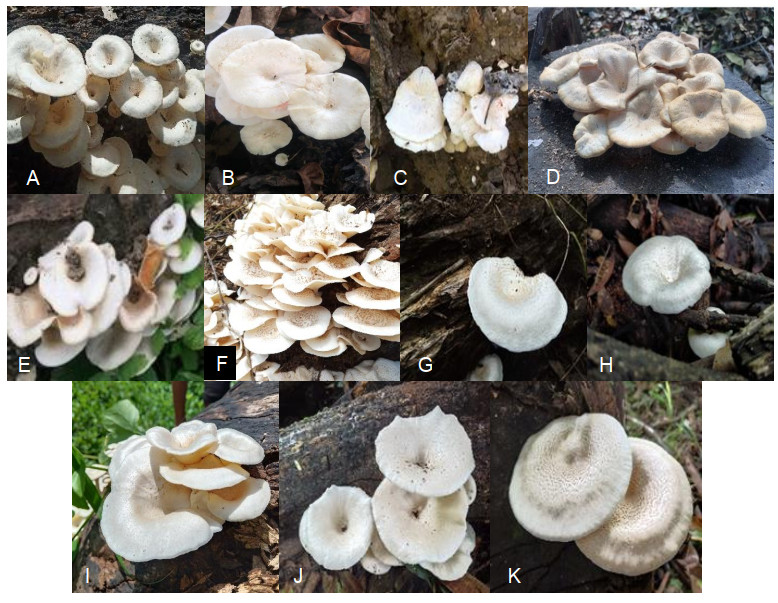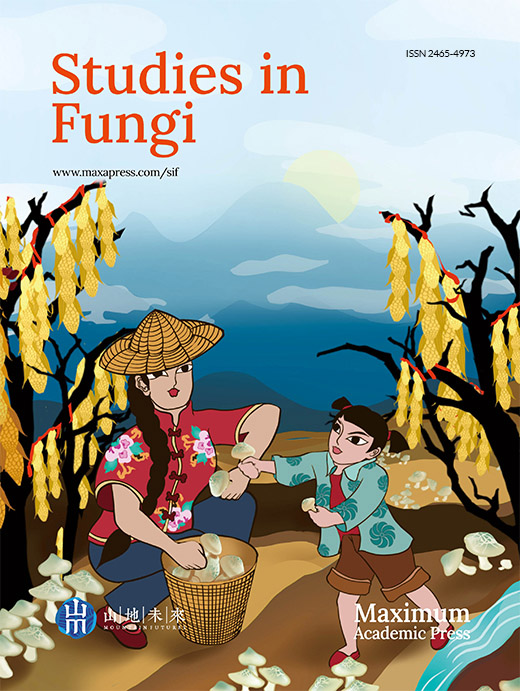HTML
-
The Philippines is known to be the second-largest archipelago that covers more than 7, 100 islands. It is blessed with very rich natural resources and remains one of the biodiversity hotspots on the planet (Myers et al. 2000, Ambal et al. 2012). In addition, Bulseco et al. (2005) reported that the Philippines is also very rich in mycological resources such as mushrooms which are in the wilderness growing on fallen logs, decomposing piles of straw, lawns, meadows, and gardens. Mushrooms have long been used for food, medicine, religion and other purposes (Molitoris 1994). Chang & Miles (1991) broadly defined mushroom as a macro fungus with a distinctive fruiting body of fungi which can be hypogeous or epigeous, large enough to be seen by the naked eye and usually picked up by hands (Rai et al. 2005). Mushroom species can be divided into four categories: edible, medicinal, poisonous, and properties undefined (Chang 2010). In the last few decades, mushrooms have increasingly been used as a source of therapeutic agents or health food supplements (Ooi 2000). It has been observed that mushroom consumers develop resistance to many types of infection, including viral, cancer, joint pains, heart ailments, and many other chronic diseases (Kim et al. 2001, Ferreira et al. 2007). Mushrooms have been reported to contain bioactive compounds with various pharmacological properties (De Silva et al. 2012). Despite the many nutritional and health benefits that can be derived from mushrooms, these macrofungal flora remain undiscovered, untapped and underutilized. In the Philippines, intensive studies on the medicinal attributes of wild plants have been conducted (Montero & Geducos 2021). At present, a number of herbal drugs are already available in the market. However, aside from plants, wild mushrooms are potential sources of biologically and physiologically active compounds for medicinal purposes. Mushrooms comprise a vast and yet largely untapped source of powerful pharmaceutical products (Ferreira et al. 2010). These mycological resources can be harnessed through culture collection and optimization of their cultural conditions for culinary, nutraceutical and pharmacological purposes.
Mushroom production in the Philippines started with the introduction of Volvariella volvacea as the first commercially cultivated mushroom species (Reyes et al. 2009a). Thereafter, mushrooms are seen as an important agricultural product in the country's local markets. However, very few mushroom species and strains are grown in the country. Some of the locally cultivated mushrooms were V. volvacea, Ganoderma lucidum, Auricularia auricula and several species of Pleurotus and Lentinus (Reyes et al. 2009a). In addition, the tropical climate in the Philippines favors growth of many wild and edible fungi. Therefore, mushroom cultivation needs to be explored with the use of local materials for mass production. This study aims to identify L. tigrinus strains that potentially have higher yield and biological efficiency to ensure their year-round availability for research and production purposes, particularly in the food, nutraceutical and pharmaceutical industries.
-
Lentinus tigrinus strains were collected from Alilem, Ilocos Sur (strain 1), Dodan, Penablanca, Cagayan (strains 2 and 3), Binanuanan, Pili, Camarines Sur (strains 4 and 5), Lingap Kalikasan (strains 6, 7 and 9), Ladies Dormitory 7 (strain 8), Sawmill (strain 10) and Grandstand (strain 11), Central Luzon State University, Science City of Munoz, Nueva Ecija (Fig. 1).

Figure 1. Wild fruiting bodies of the different geographical strains of L. tigrinus: (A) strain 1 from Alilem, Ilocos Sur; (B) strain 2 and (C) strain 3 from Dodan, Penablanca, Cagayan; (D) strain 4 and (E) strain 5 from Binanuanan, Pili, Camarines Sur; (F) strain 6, (G) strain 7 and (I) strain 9 from Lingap Kalikasan; (H) strain 8 from Ladies Dormitory 7; (J) strain 10 from Sawmill; (K) strain 11 Grandstand, Central Luzon State University, Science City of Munoz, Nueva Ecija.
Tissue culture
-
The collected L. tigrinus mushrooms were brought to the laboratory in order to rescue the cell lines following the standard tissue culture protocol for mushroom (Reyes et al. 2009b). Fruiting bodies of L. tigrinus were brushed to remove the dust, soaked in 10% sodium hypochlorite for 1 minute, then rinsed three times with distilled water (De Leon et al. 2013). Fruiting body was cut longitudinally in order to expose the inner portion. Internal sterile tissues (5 x 5 mm2) from the fruiting body were obtained using a sterile surgical blade and inoculated into the left of petri dish plates pre-filled with 15 ml potato dextrose agar (PDA). The culture plates were incubated at room temperature until the mycelia has fully ramified the petri plates. The fully ramified petri plates were stored in glass chambers until further use.
Grain spawn preparation
-
The grain spawn was prepared by boiling 3 kg of unmilled rice in 3 liters of water until cooked. The boiled seeds were allowed to cool down and the moisture content was maintained at 65%. Thirty grams was placed in 5 x 8 inch autoclavable polypropylene plastic bag, plugged with cotton and sterilized using an autoclave at 121℃, 15 psi for 30 min. The sterilized bagged seeds were allowed to cool overnight. Each bag was inoculated with one 10 mm mycelial agar block of pure culture of the organism and incubated at room temperature until full mycelial ramification.
Evaluation of fruiting body production
-
The rice straw-sawdust based substrate formulation was prepared following the procedures outlined by Reyes et al. (2009b). This formulation consists of 70% composted rice straw and 30% composted sawdust v/v with a moisture content of 65%. Approximately 500 g of formulated substrates were placed and compacted in a heat resistant 8 x 11-inch polypropylene plastic (pp) bags. The opening of the pp bags were plugged with cotton with the help of plastic rings polyvinyl chloride (pvc) which served as its neck. The bagged substrates were pasteurized at 80℃ for 8 h. The pasteurized bags were transferred to the inoculation room and allowed to cool down overnight. Each bag was opened by removing the cotton plug and inoculated with 30 g grain spawn of L. tigrinus. The inoculated fruiting bags were incubated at room temperature until completely ramified with mycelia. Incubation period refers to the number of days from inoculation to full colonization of the substrate. The fully ramified bags were opened at both ends to allow fruiting initials to develop into mature basidiocarps. The appearance of the fruiting initials or the primordia is an important stage prior to fructification. The appearance of primordia signals the formation of fruiting bodies. Hence, the duration from inoculation of the substrate to the appearance of the primordia was recorded. Matured fruiting bodies were harvested and weighed to determine the yield and biological efficiency. The yield and biological efficiency (BE) are two important parameters to be considered in mushroom production. The yield refers to the weight of mushrooms produced, while the biological efficiency is the ability of the mushroom to convert the substrates into fruiting bodies.
Statistical Analysis
-
The experiment was laid out following the completely randomized design. All treatments were replicated three times. The data were analyzed using SAS program. Means were compared using Tukey's HSD.
Source of wild mushrooms
-
The incubation period of different L. tigrinus strains are shown in Table 1. The incubation period ranged from 16.6 to 40.5 days. The shortest incubation period was demonstrated by strain 10. However, this is comparable with strain 11 (18.00 days) and strain 6 (18.10 days). On the other hand, the longest incubation period was observed in strain 1.
Table 1. Incubation period, primordial initiation, cap diameter, stipe length, yield and biological efficiency of 11 strains of Lentinus tigrinus grown on rice straw-sawdust based substrate.
Mushroom Species Incubation Period (days) Days to Primordia Initiation (days) Pileus Diameter (mm) Stipe Length (mm) Yield per bag(g) Biological Efficiency (%) Lentinus tigrinus 40.50d 44.00f 56.09bc 37.64abc 30.77cd 6.15cd strain 1 ±2.00 ±1.37 ±2.43 ±2.44 ±1.51 ±0.30 Lentinus tigrinus 20.70b 23.00ab 40.75de 27.91d 14.38def 2.86def strain 2 ±1.40 ±1.41 ±6.56 ±1.13 ±0.95 ±0.19 Lentinus tigrinus 20.10b 21.10a 59.37abc 29.30bcd 24.67cde 4.93cde strain 3 ±1.85 ±3.03 ±2.30 ±2.74 ±2.75 ±0.55 Lentinus tigrinus 20.80b 26.20b 50.80bcd 26.47d 4.33f 0.87f strain 4 ±1.52 ±1.82 ±4.54 ±5.71 ±1.44 ±0.29 Lentinus tigrinus 27.90c 33.10cd 33.19e 28.65cd 7.33ef 1.47ef strain 5 ±2.33 ±2.41 ±4.85 ±3.33 ±1.26 ±0.25 Lentinus tigrinus 18.10ab 31.60c 72.20a 38.20ab 81.83a 16.37a strain 6 ±0.22 ±0.55 ±5.61 ±1.05 ±12.87 ±2.57 Lentinus tigrinus 21.20b 37.30e 62.39ab 31.96abcd 59.00b 11.80b strain 7 ±0.27 ±0.45 ±3.20 ±1.32 ±5.77 ±1.15 Lentinus tigrinus 20.60b 32.40c 53.28bcd 35.27abcd 36.50c 7.30c strain 8 ±0.89 ±0.89 ±4.96 ±5.06 ±15.02 ±3.00 Lentinus tigrinus 29.70c 36.30de 47.73cd 39.24a 28.50cd 5.70cd strain 9 ±0.67 ±0.76 ±5.95 ±3.85 ±1.80 ±0.36 Lentinus tigrinus 16.60a 20.70a 50.71bcd 41.22a 14.67def 2.93def strain 10 ±0.89 ±0.27 ±2.97 ±3.57 ±1.26 ±0.25 Lentinus tigrinus 18.00ab 22.00a 49.48bcd 33.16abcd 15.50def 3.10def strain 11 ±2.74 ±3.04 ±3.09 ±1.56 ±7.37 ±1.47 Means with the same superscript are not significantly different at 5% levels of significance The duration of the emergence of primordia of the different strains ranged from 20.7 to 44 days. L tigrinus strain 10 recorded the fastest time to produce primordia (20.70 days), which is statistically comparable with strains 2, 3 and 11 with means of 23, 21.1 and 22 days, respectively. On the other hand, the longest time to form fruiting body initials was noted in strain 1.
The mushroom fruiting bodies consist of stipe and pileus. The stipe is the stem or stalk while the pileus is the cap of the mushroom. The size and morphological characteristics of the mushroom are inherent characteristics of the species. The pileus diameter and stipe length of the fruiting bodies are presented in Table 1. Among L. tigrinus strains evaluated, the widest mean pileus diameter was exhibited by strain 6 (72.2 mm), which is comparable to strains 3 (59.37 mm) and 7 (62.39 mm). On the other hand, strain 5 (33.19 mm) registered the smallest mean pileus diameter. The longest stipe was observed in strain 10 with a mean of 41.22 mm, which is statistically similar with strains 1, 6, 7, 8, 9 and 11 with means of 37.64 mm, 38.20 mm, 31.96 mm, 35.27 mm, 39.24 mm and 33.16 mm, respectively. Meanwhile, the shortest stipe was noted in strain 4 with a mean value of 26.47 mm.
The biological efficiency is always correlated with the yield. Table 1 also presents the yield and BE of different L. tigrinus strains. It can be seen that the highest yield was recorded in strain 6 with a mean yield of 81.83 g with a corresponding biological efficiency of 16.37%. However, the lowest yield and biological efficiency were recorded in strain 4 with mean value of 4.33 g and 0.87%, respectively.
Fruiting body production of the different strains of Lentinus tigrinus
-
Variation in different growth parameters, namely: incubation period, duration of primordia initiation, diameter of the pileus, length of the stipe, yield, and biological efficiency was noted among 11 strains of L. tigrinus evaluated. The results obtained in the present study suggest that these parameters are species and strain-dependent. It is interesting to note that variation in the incubation period is observed among strains. This agrees with the report of Osman et al. (2009) who disclosed that the two strains of Lentinus edodes exhibited variation in the duration of incubation period. Moreover, Lechner & Alberto (2011) observed Pleurotus albidus strains differ in the duration of mycelial colonization of the substrates. Elsacker et al. (2020) explained that hyphal tip extension and radial branching are controlled by certain environmental conditions (incubation temperature, moisture level, relative humidity, light and air) specific to the fungal organism and its lifestyle. For example, Joshi et al. (2020) noted different responses of selected mushroom species to various substrates in terms of mycelium morphology and density. Aside from mushroom species and strain, they also reported that particle size of substrate plays an important role in mycelium penetration. Furthermore, Bellettini et al. (2015) disclosed that even though small particle size is preferred for the mycelium to effectively penetrate the substrate, making the particle size too small may also disrupt the oxygen supply in the substrate, thus slowing down the incubation period. Thus, creating a formulation where mycelium penetration can be most effective is imperative.
Primordial formation is the beginning of fruiting body production in mushroom. Wood (1976) defined primordia as structures greater than 1 mm diameter composed of hyphal mesh with a smooth surface and visibly distinct from strands or knots of hyphae. Several factors affect primordia initiation such as temperature, humidity, and carbon dioxide concentration, substrates, and strain (Baars et al. 2020, Mkhize et al. 2016, Girmay et al. 2016). However, Martos et al. (2017) noted that temperature did not significantly affect the earliness of fructification in Agaricus subrefescens. Sakamoto (2018) reported the importance of light in early pileus primordia formation of Polyporus arcularius and Flammulina velutipes. Kűes & Navarro-Gonzales (2015) disclosed that the most active wavelength responsible for initiation and maturation of fruiting bodies is found in the blue/UV range. The results obtained in the present study conform to Baars et al. (2020) which revealed that some strains of Agaricus bisporus pin easily, others are more difficult to pin. In a related study, Kalaw & Albinto (2015) disclosed a significant difference in the duration of primordial initiation of different species of Pleurotus cultured on rice straw-based substrate formulations. Likewise, Noble et al. (2003) reported that strains of A. bisporus differ in their primordia development. Variation in the duration of primordia initiation observed among L. tigrinus strains evaluated implies that the appearance of primordia is also strain-dependent.
It was also evident that the diameter of pileus and length of stipe of L. tigrinus strains differ significantly. This observation implies that these parameters are inherent characteristics of the species and strain. Apart from this, the size of the fruiting bodies could also be due to the strain-specific responses in terms of nutrition and environment. Halbwachs & Karasch (2019) noted that certain mushrooms species, such as Schizophyllum commune could be extremely variable in size due to its ability to adapt to certain environmental conditions that may have affected its morphological traits. In addition, Sáchez-Garcia et al. (2020) suggested that pileate-stipate shaped basidiocarps are correlated with elevated diversification rates, a probable morphological trait linked to the evolutionary success of Agaricomycetes.
The yield and biological efficiency are the two most important growth parameters used in the selection of the best strain for large scale mushroom production. In the present study, it was noted that the 11 strains performed differently in these aspects. This observation may be due to the inherent genetic characteristics of the L. tigrinus strains. The findings of the present study conform to the previous reports. For instance, Dhakad et al. (2015) disclosed that among five strains of Calocybe indica CI14 strain produced the highest yield compared to the other strains. Myronychyva et al. (2017) revealed that differences in growth parameters like yield and biological efficiency also exist in 12 Pleurotus ostreatus and 6 Pleurotus pulmonarius strains. Some strains recorded higher yield and biological efficiency than the other strains. Peng et al. (2000) also reported different yield and biological efficiency of Plerurotus eryngii strains ATCC 36047 and Holland 150 supplemented with 48% and 38% sawdust respectively. Likewise, Moonmoon et al. (2010) reported difference in the growth and yield of different Pleurotus eryngii strains cultured on two substrate formulations. They explained that the difference might be due to the difference in the genotype of mushroom strains and the substrate. In a similar study, Patel et al. (2019) disclosed significant variation in yield and biological efficiency in five species of Pleurotus. Lechner & Alberto (2011) noted that five strains of P. albidus, grown on the same substrate, exhibited varying biological efficiencies and yields. Aside from the species and strains of mushrooms, the yield is also dependent on the substrate, most specifically cellulose, lignin and fiber contents (Obodai et al. 2003). For example, Owaid et al. (2015) reported the variation in yield of four oyster mushroom species on rice bran and sawdust substrates. Koutrotsios et al. (2014) revealed that some species exceed 100% biological efficiency suggesting that the performance may be affected by the type of species and strains used. Higher yields could be observed in supplemented substrates such as in Calocybe indica (Alam et al. 2010). Several studies confirm that the addition of nitrogen sources increases the yield and % BE significantly (Mane et al. 2007, Salama et al. 2019).
Hence, it can be concluded that variation does not only exists between species but also within species of mushrooms. The observed variations could be due to the inherent characteristics of the different strains. Among strains evaluated, strain 6 followed by strain 7 could be considered as superior strains, suggesting their promising potentials for commercial cultivation. However, in order to further improve the yield performances of the different strains, the addition of supplements is highly recommended. The effect of supplementation on the yield performances of weaker strains must also be evaluated.
-
The authors would like to thank DOST-PCHRD for funding this research. Our sincerest gratitude to the Local Government Unit of Sugpon, Ilocos Sur; Allilem, Ilocos Sur; Penablanca, Cagayan; and Pili, Camarines Sur and those who assisted us in one way or another in the conduct of this research.
- Copyright: © 2021 by the author(s). This article is an open access article distributed under Creative Commons Attribution License (CC BY 4.0), visit https://creativecommons.org/licenses/by/4.0/.
| SP Kalaw, AM De Leon, EJ Damaso Jr., JC Ramos, MAG del Rosario, MD Abon, JR Undan, RMR Dulay, RG Reyes. 2021. Cultivation of different strains of Lentinus tigrinus from selected areas of Luzon Island, Philippines. Studies in Fungi 6(1):299−306 doi: 10.5943/sif/6/1/20 |












